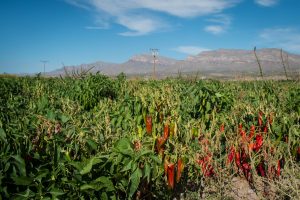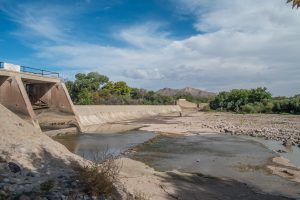After a great day-and-a-half gathering of the New Mexico water nerds in Silver City (the 61st annual New Mexico Water Conference, put on by New Mexico State University’s Water Resources Research Institute, I took a leisurely drive this afternoon along one of my favorite stretches of the Rio Grande.

Hatch chiles
The Hatch Valley (more formally known as the “Rincon Valley”, but if you’ve ever eaten the chiles you’ll know why the “Hatch” name stuck) is a working landscape, and the Rio Grande here is a river turned in service of that work. Two big reservoirs, Elephant Butte and Caballo, regulate the river’s flow into the valley, and that flow is entirely managed to meet the needs of farming and other human water uses.
The interstate hugs bluffs along the valley’s eastern edge, but if I have time I always take NM 187 along the valley floor. It doesn’t take much longer. It’s a way to see how we use water in New Mexico, turning it out of the river and growing stuff with it. It’s the tail end of chile season, I smelled some onions, I saw an old pump chugging up some groundwater onto an alfalfa field to squeeze out another cutting, and big stretches of pecan orchards.

Percha Dam, with no water, Rio Grand, Hatch Valley, October 2016
But the river itself?
There was still some standing water in the Rio Grande’s channel. But when I got out to Percha Dam, the irrigation diversion structure at the head of the valley, the river itself was dry. This is a river entirely managed for human use. On Oct. 1, they turned it off.
As I said, it’s one of my favorite stretches of the Rio Grande. But it’s really weird to see a river turned off.

As I crossed the Rio Grande via the Alameda Bridge yesterday, Friday, morning the river was lower than I’d seen it in a long time. Looked to me like it had dropped at least a foot since I rode by on Monday. It hasn’t been that dry in the watershed, has it? Or are they allowing a dam(s) upstream to fill?
Bill – It’s a similar explanation up here. Irrigation season is winding down, so they’ve slowed the releases of water stored earlier in the year behind El Vado and Abiquiu. There’s still some water being released from Abiquiu (not sure whose). Without that, it’d probably be completely dry here.
Thanks for the explanation. Am I right there is still some minimum flow mandated to protect the Silvery Minnow in the middle Rio Grande valley? And is Albuquerque’s San Juan purchased water supposed to be available year around?